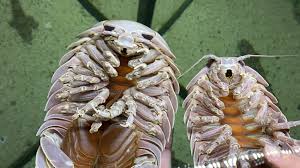
Rubber Ducky Isopods: A Quirky Twist on a Marine Favorite
The deeply water is a entire world that continues to be largely unexplored and strange to most of us. Its depths are teeming with all sorts of unusual and fascinating creatures, from bioluminescent jellyfish to giant squid. But just about the most interesting and enigmatic of those strong-sea creatures will be the giant isopod. These outrageous-looking animals look like some thing away from a science fiction motion picture, making use of their spiny carapaces and long antennae. In this post, we shall investigate the industry of giant isopods, and learn exactly what makes these critters so intriguing.
1. What are giant isopods? Giant isopods are a kind of strong-water crustacean that belong to the family unit of wildlife known as isopods. The biggest type of giant isopod can grow up to 2 as well as a half ft . extended and might consider as much as four lbs. These people have a difficult, spiny exoskeleton that protects them from predators, as well as very long antennae they normally use to sense their surroundings.
2. Where do giant isopods stay? Giant isopods are located in the deepest parts of the ocean, primarily from the Atlantic and Pacific Oceans. They may be found at depths as high as 7,000 ft, the location where the pressure is over 200 times more than on the surface of the seas.
3. Precisely what do giant isopods take in? Giant isopods are scavengers, giving about the carcasses of old pets that basin to the foot of the seas. They have a effective mouthful they use to destroy into the challenging exterior shells of crabs along with other crustaceans, they will then prey on.
4. What are some of the adaptations that giant isopods have to survive inside the serious sea? Giant isopods are tailored to our lives inside the deeply sea in numerous ways. For starters, they have a slow-moving fat burning capacity, which allows them to live for too long time periods between foods. They likewise have large antennae that they can use to locate possible meals resources and browse through in their darker and murky atmosphere.
5. Why are giant isopods important? Giant isopods are crucial signals of the fitness of the strong sea ecosystem. As they are near the top of the foodstuff sequence within the serious sea, these are significantly influenced by any alterations in the ecosystem, such as air pollution or overfishing. By researching giant isopods and tracking their populations, researchers can obtain advice about the fitness of the deep ocean ecosystem in general.
Simply speaking:
In In a nutshell, giant isopods are truly interesting creatures of the serious seas. With their spiny exoskeletons, long antennae, and remarkable dimension, they may be both outrageous and delightful. Although a lot is still unidentified about their habits and conduct, perform realize that they engage in a vital role from the deeply ocean ecosystem. As we continue to investigate the depths in the sea, we shall undoubtedly learn more interesting facts about these strange animals.